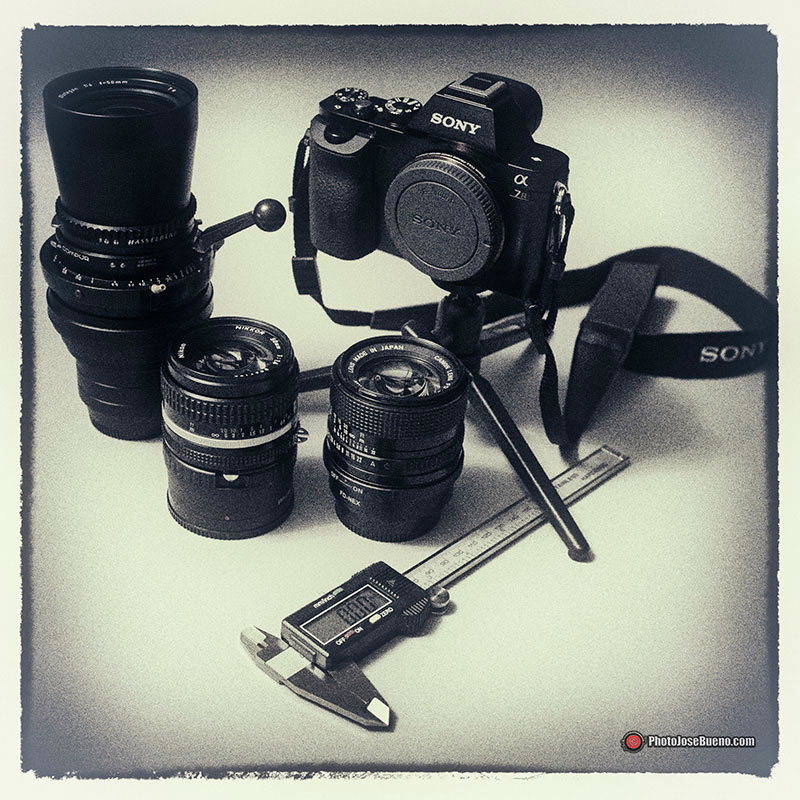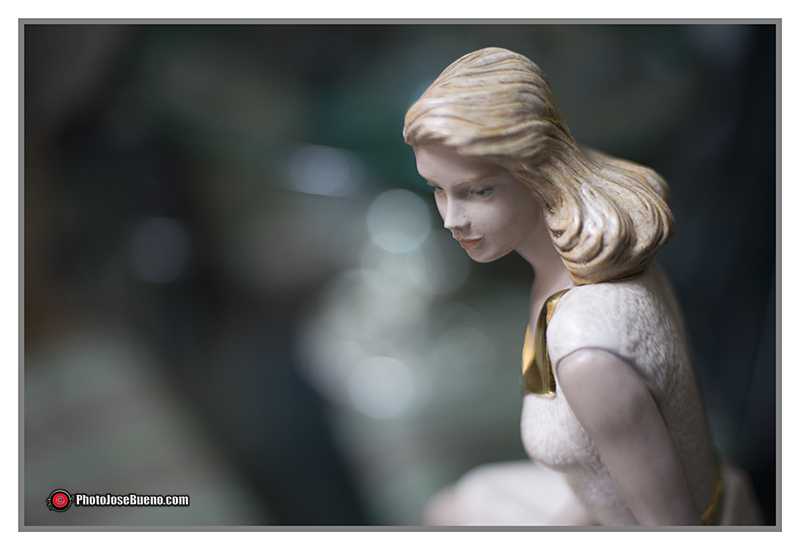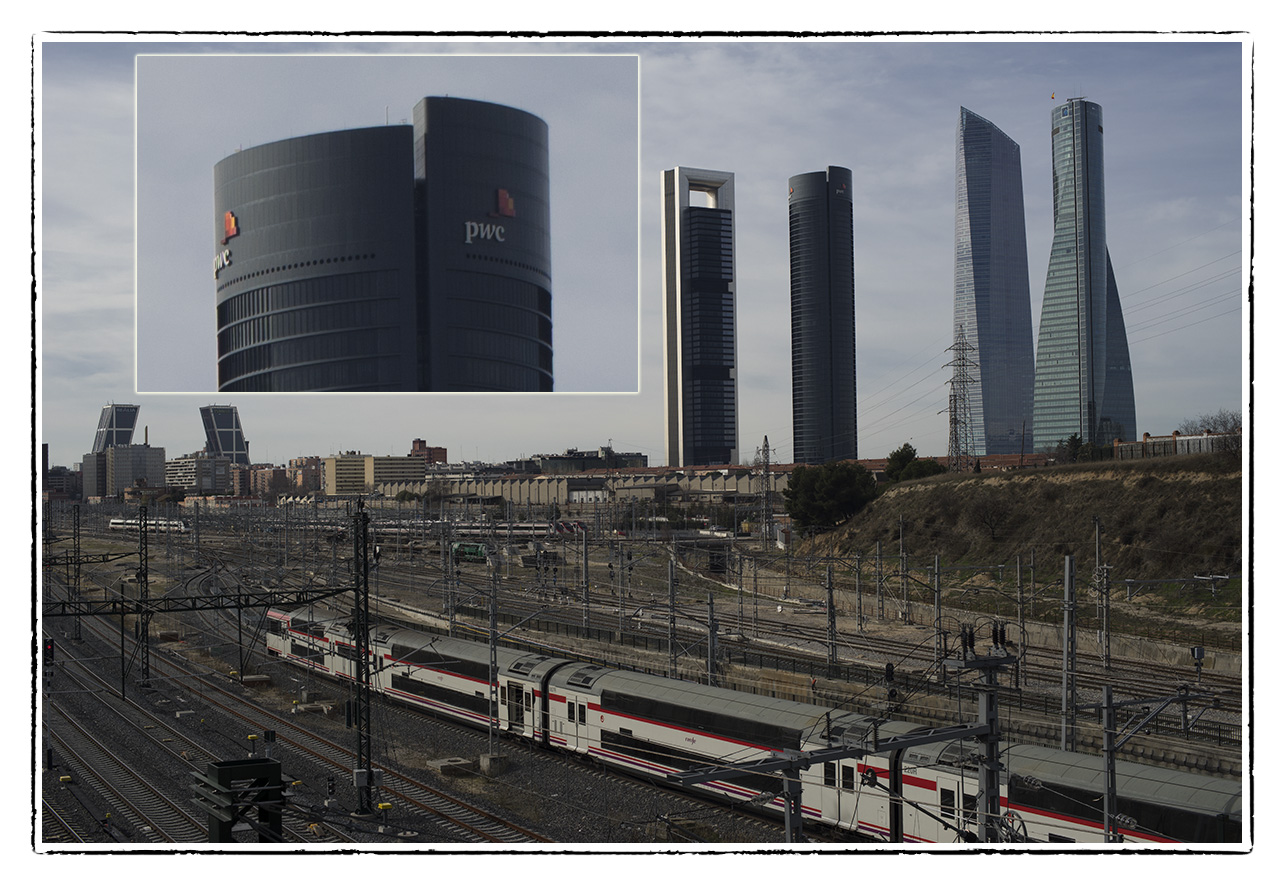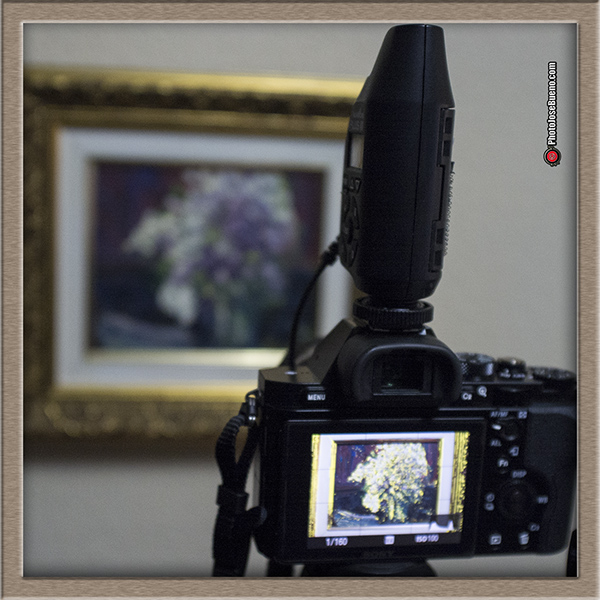Estoy convencido que hace más de 30 años, cuando las marcas Canon, Nikon o Carl Zeiss fabricaron los objetivos que hoy vamos a probar con sus distintas bayonetas solo compatibles son los cuerpos de su marca o Hasselblad en el caso Zeiss nunca habrían imaginado que esos cristales funcionarían en un cuerpo de otra marca con su correspondiente adaptador y sin carrete.
Precisamente en la década de los 70 y 80, a diferencia de hoy, comprar una cámara réflex no estaba al alcance de muchos aficionados y suponía un gran esfuerzo para un profesional realizar esa inversión. Unas cámaras que hoy miramos con añoranza y que incluso algunas marcas imitan y trasladan su diseño a modelos actuales.
En esos años tampoco era frecuente vestir a la nueva compañera con los típicos zoom todo terreno que hoy suelen acompañar a cámaras de consumo. En esos tiempos se solía empezar por una focal lo más parecida posible a la visión humana, me refiero al típico 50mm. que lógicamente en función del presupuesto era más o menos luminoso. Es por ello que a nuestra flamante Sony A7R la vamos a someter como si de un árbitro imparcial se tratase a que nos de su veredicto respecto a si el famoso Nikkor 50 1.4 AIS es mejor o peor que el Canon 1.4 FD de la época. Estoy seguro que ambos librarán una dura batalla y que ambos son perfectamente utilizables en un cuerpo tan generoso como es el de la Sony A7R.
Para darle un poco de sal a esta prueba hemos incluido también otro 50mm. que aún siendo menos luminoso, es un f:4, es un objetivo mítico en el medio formato. Por supuesto que este objetivo por tamaño y algún detalle más, no es tan usable como los antes mencionados pero ya puestos y por el mismo precio al menos veremos cuan generoso es en su color, definición, contraste, etc. Soy consciente que en medio formato el objetivo “estándar” o equivalente sería el 80mm. pero recordar que el ángulo de visión es lo que cuenta y es que ese 50mm. en un formato 6×6 el ángulo de visión diagonal es de 77º mientras que esa misma visión en formato full frame es de 46º, muy parecido a los Canon y Nikkor que vamos a probar.
Para empezar, mi opinión es que tanto el Canon como el Nikkor le sientan fenomenal a está cámara en cuanto a tamaño y usabilidad. Ambos objetivos tienen un tamaño y peso contenido si bien es cierto que el volumen se ve algo perjudicado por el aumento del adaptador pero es algo que no me importa si pensamos en las ventajas. Aún así tanto el peso total como el tamaño, sigue siendo menor que cualquier réflex full frame con un 50mm. actual.
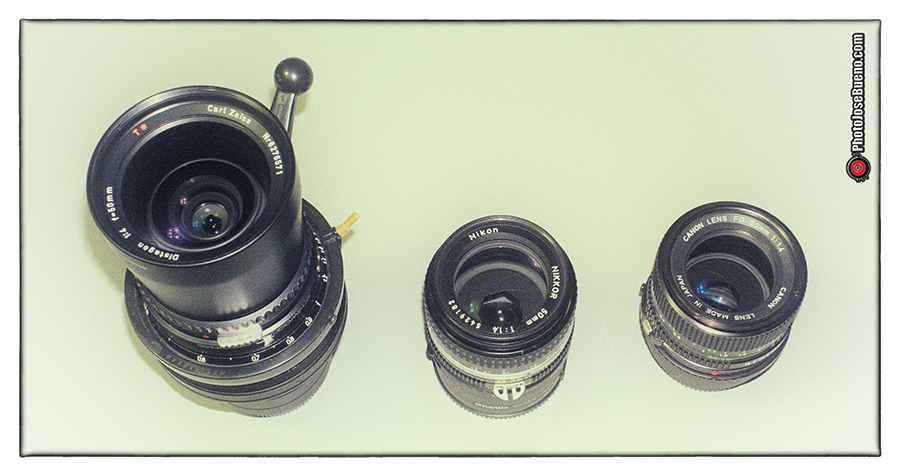
Si tuviésemos que dar un punto a una de las dos ópticas por tamaño y peso, sería un punto para Canon, eso si, ganado de penalti en el último minuto y es que sus 235gm de peso contra los 249gm del Nikkor son inapreciables, ambos son muy ligeros. También son 3 insignificantes milímetros la longitud de objetivo más adaptador a favor de Canon (65,5mm) respecto al Nikkor (68,5mm). Sinceramente en este apartado no tomaría ninguna decisión por motivos de tamaño o peso.
Ambas ópticas son capaces de enfocar desde 0,45 metros, y las dos disponen de una luminosidad f:1.4. Es en la parte alta donde Canon ofrece más rango pues es capaz de cerrar a f:22 mientras que el Nikkor se queda en f:16. Pero hay que tener en cuenta que en fotografía digital estos diafragmas tan cerrados producen la famosa aberración cromática que aumenta linealmente con el radio de abertura. Aún así, nuevo punto para Canon.
Si hay algo que a priori me ha gustado más de Canon, ha sido que tiene una hoja más en su diafragma, 8 hojas frente a los 7 del Nikkor y eso puede afectar, o no, al bokeh, lo comprobaremos. También Canon tiene medios pasos para el diafragma, cosa que el Nikkor no dispone. Nuevo punto para Canon que va ganando por goleada, pero …, dejemos los números y teorías y probemos ambos objetivos para ver si somos capaces de discernir un ganador. Ah! Y en esta ocasión de paso nos llevamos el Carl Zeiss Distagon 50mm f:4 ya que como dije antes no es comparable pero tengo curiosidad respecto a su comportamiento.
Todas las tomas se han realizado bajo las misma condiciones de luz (modo manual con igual ISO, diafragma y velocidad), sin filtros y con trípode cuando ha sido posible. Aprovechando esto último que he comentado, si vas a comprar un adaptador para cualquier tipo de objetivo, estaría bien decidirse por los que llevan rosca para poner ahí el trípode y liberar peso y estrés a la bayoneta de la Sony. Afortunadamente los tele objetivos actuales llevan esa rosca pero si no es así, el sistema de que sea la bayoneta de la cámara la que soporta todo el peso de adaptador y objetivo no me gusta.
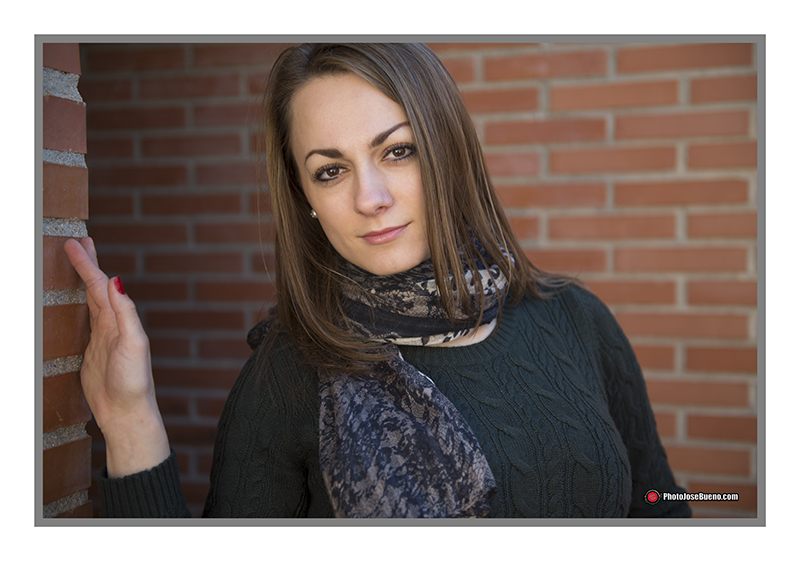
Modelo: Aura Sony A7R – Nikkor Ais 50mm. 1.4 – 1/400s – f:2.8 – ISO 200
Para la prueba he realizado fotografías a una de mis viejas pinturas, fotos de exteriores con enfoque al infinito y en condiciones de luz complicadas (casi contraluz) y fotos a una modelo amiga, gracias Aura.
Anticipo que el comportamiento de los tres objetivos ha sido distinto y muy interesante de analizar.
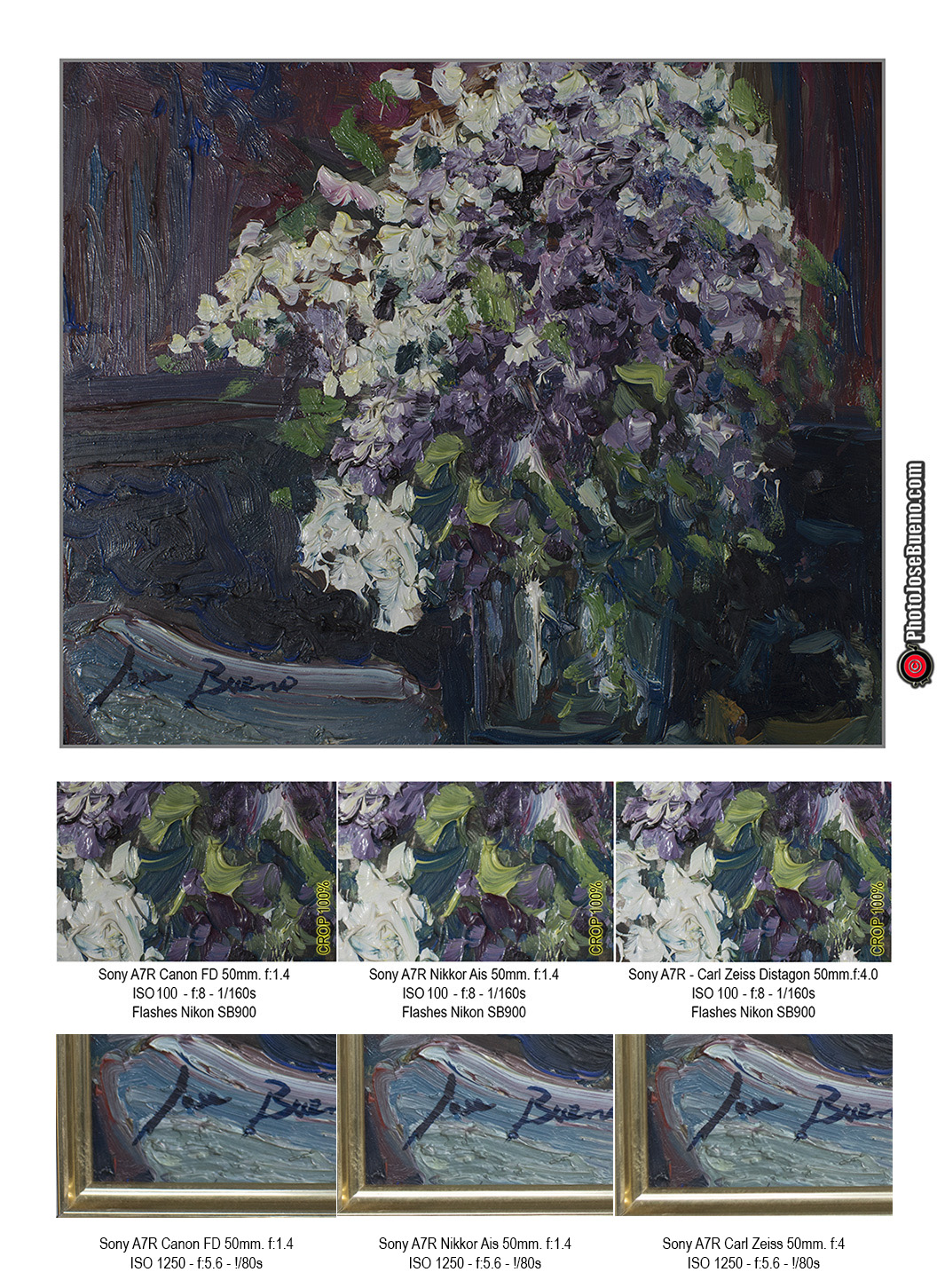
Canon FD 50mm. 1.4
Este objetivo es más suave que sus contrincantes en todas las situaciones, me refiero en las cortas como en las largas distancias así como en máxima y media apertura. Es por eso que quizás sea un objetivo ideal para retrato pues su comportamiento ayuda en ocasiones a definir menos esos poros que entre otros siempre hay que retocar cuando la modelo no lleva maquillaje de base.
A igual velocidad, Iso y diafragma, todas las fotos salen con medio punto menos de luz. Su color es bastante fiel a la carta de colores siempre y cuando compensemos ese medio punto de oscuridad que tiene y que por cierto no me desagrada. De todas formas ese tema es tan sencillo de corregir como realizar una compensación de la exposición con la rueda que tiene la A7R en la parte superior, por cierto a la antigua usanza.
Libre de viñeteos, este objetivo si que presenta al igual que el Nikkor un claro efecto barrilete. En otra ocasión quiero ver su es posible arreglar con una aplicación que Sony ofrece y que es capaz de corregir entre otros estos temas.
El bokeh que ofrece este Canon FD a máxima apertura (f:1.4) es muy bueno y quizás algo más “dulce” en aperturas como f:4.0
Nikkor Ais 50mm. 1.4
Es con diferencia el objetivo más agudo en la zona central y con diafragmas superiores a f:2.8. Sin embargo a f:1.4 sus esquinas se difuminan de forma clara aunque no alarmante. A pesar de no disponer de diafragmas intermedios, es una óptica perfecta para llevar siempre en nuestra flamante Sony A7R.
También ofrece más contraste que sus rivales, lo que unido a esa mayor definición y un color excelente, le hace una opción muy interesante para esta cámara.
Al igual que el Canon, este objetivo está libre de viñeteo aunque también presenta un claro efecto barrilete como ya se ha comentado anteriormente.
El bokeh a máxima apertura (f:1.4) es muy cremoso e interesante y a pesar de ser el más contrastado en este apartado también es ganador comparándolo con el Canon FD.
Carl Zeiss Distagon 50mm f:4
Como ya anticipaba al inicio, este objetivo no es muy “transportable” con un cuerpo tan bolsillero pero es un objetivo muy interesante para estudio ya que su profundidad de campo a igual diafragma es mayor que los otros dos objetivos probados y es que no hay que olvidar su adn es de gran angular a pesar de que en un sensor full frame sigue siendo un 50mm.
El comportamiento en comparación con los otros, ha sido con diferencia el más estable en cuanto a definición en todos los diafragmas así como en fidelidad de color pero ojo es un objetivo que a pesar de su tratamiento antirreflejos firmado por las ópticas Zeiss con la famosa T*, no le sienta nada bien los contraluces, la luz lateral o con flash sin parasol y es que el sensor de la Sony es mucho sensor.
El bokeh que ofrece el Distagon, en comparación con los Canon y Nikon es quizás el más recomendable para ese tipo de fotografías. Pero dicho esto y como ya he comentado, es el que más profundidad de campo tiene y eso también es un plus en otro tipo de imágenes.
Otra ventaja es que este ha sido con diferencia el objetivo que menos efecto barrilete tiene con un ángulo de visión un poco más abierto (como un par de grados más).
Conclusión
Ha sido todo un placer descubrir y sacar de la vitrina estas dos ópticas Canon y Nikon y usarlas en esta cámara Sony. Un placer trabajar con el preciso sistema focus peaking de la Sony A7R, todo un invento que ayuda a dar una segunda oportunidad a todas esas increíbles ópticas.
Sin descartar las ópticas nativas Zeiss que Sony tiene previsto ir comercializando y que estoy deseoso de probar, de momento y ciñéndonos a la prueba de esta entrada, mi opinión es que utilizaré indistintamente ambos 50mm. y si bien he de reconocer que a priori me convencía más el Canon FD, para uso más diario me ha gustado más la definición y contraste del Nikkor pero también quiero disfrutar de ese Canon FD más suave en fotografías concretas.
Por otra parte el Carl Zeiss que puedo utilizar en la Hasselblad, es muy posible que también utilice en el estudio con esa Sony de 36mb. No se me quita de la cabeza otra interesante prueba para medir el rendimiento en estudio de esta Sony y toda una Hasselblad 503cx con un respaldo digital Phase One. Tranquilo que esa prueba tengo muchas ganas de hacerla en un plazo razonablemente corto y se quién es la ganadora al menos en Isos altos.
Lo que si tengo claro es que la Sony A7R es toda una revolución y desde aquí felicito y doy las gracias a Sony por crear una cámara capaz de dar esa segunda oportunidad a esas ópticas mayores en el tiempo pero con una calidad y precio más que interesante. Esta cámara además de utilizarla en estudio, estoy convencido que me acompañará en mis viajes y por supuesto en esos días melancólicos en los que te apetece disfrutar de la fotografía en el campo.
Dress the Sony A7R with Canon VS Nikon and some heavyweight
I am convinced that over 30 years ago, when Canon, Nikon or Carl Zeiss brands manufactured goals today we will try its different only compatible bayonets are the bodies of their brand or Hasselblad on the Zeiss case would never have imagined that these crystals would work in a body of another brand with its corresponding adapter without reel.
Precisely in the 70s and 80s, unlike today , buying a DSLR camera was not available to many fans and it was an effort to make the investment professional . Some cameras today and look longingly mimic and even some brands move their design to current models.
In those years was not often dress the new companion with typical zoom road today often accompany consumer cameras . In those days they used to begin with a focus as close as possible to human vision , I mean the typical 50mm . logically according to the budget was more or less bright. That is why our brand new Sony A7R we will submit as if it were an impartial referee to give us their verdict on whether the famous Nikkor 50 1.4 AIS is better or worse than the Canon FD 1.4 of the time. I’m sure both fight a heavy battle and both are perfectly usable as generous as is the Sony A7R body.
To give a little salt to this test we have also included another 50mm . still being less bright, f is 4 , is a mythical target in the medium format . Of course this goal by size and some more detail , it is not as usable as the above but it stalls and for the same price at least see how generous is in color, sharpness, contrast , etc. . I am aware that in medium format «standard » or equivalent would be the 80mm lens . but remember that the angle of view is what counts and that is 50mm . 6×6 format on a diagonal angle of view is 77 ° while the same view on full frame format is 46 °, very similar to the Canon and Nikkor are going to try.
For starters, my opinion is that both Canon and Nikkor you feel is phenomenal camera in size and usability. Both objectives have size and light weight while it is true that the volume is somewhat handicapped by the increase of the adapter but it’s something I do not care if we think of the advantages . Yet both the total weight and size, is still smaller than any DSLR with full frame 50mm . current .
If we had it to a point to one of the two optical by size and weight , it would be a point to Canon , that if won a penalty in the last minute and it is their 235gm weight against 249gm of Nikkor are invaluable , both are very light . Also insignificant is 3 mm length more objective adapter for Canon ( 65.5 mm ) compared to the Nikkor ( 68.5 mm). Sincerely in this section would not take any decision on the basis of size or weight .
Both lenses are able to focus from 0.45 feet, and the two have a bright f:1.4. It is at the top where Canon offers more range it is able to close f:22 while the Nikkor stays f:16. But keep in mind that in digital photography these very small apertures produce the famous chromatic aberration that increases linearly with the radius of aperture. Still, new point for Canon .
If anything I liked a priori over Canon, has been having over a leaf in her diaphragm, compared to 7 8 sheets of Nikkor and that can affect or not the bokeh, we will check . Canon also has half steps to the diaphragm , which does not have the Nikkor . New point for Canon ‘s winning by a landslide , but … let the numbers and theories and prove both goals to see if we can discern a winner. Ah ! And this time passing the Carl Zeiss Distagon 50mm f we get 4 because as I said before is not comparable but I’m curious about their behavior .
All shots were made under the same light conditions (manual mode with the same ISO , aperture and shutter speed ) without filters and tripod when possible . Taking advantage of this last that I mentioned , if you buy an adapter for any purpose , would be fine decided by the leading thread to put the tripod and there weight and stress release bayonet Sony . Fortunately the current objectives tele carry that thread but if not, the system that is the bayonet camera which supports the entire weight of adapter and target do not like.
For testing I have made photographs of my old paintings, photos of exterior and infinity focus condition (almost backlight) complicated light and photos to a model friend , thanks Aura.
I anticipate the behavior of the three objectives was different and interesting to analyze.
Canon FD 50mm . 1.4
This lens is softer than their opponents in all situations , I mean in the short and long distances as well as maximum and average opening . That’s why maybe an ideal portrait lens for his behavior helps sometimes less define these pores among others always have to tweak the model when not wearing makeup base.
At the same speed, ISO and aperture, all the pictures are less than half a point light. Its color is pretty true to the color chart provided that we compensate the midpoint of darkness that has and certainly not dislike me. Anyway this issue is as simple as making a correct exposure compensation with the wheel having the A7R at the top, by the way the old fashioned way.
Royalty vignetting , this goal if posing as skipjack Nikkor clear effect . On another occasion I can see your fix with an application that Sony offers and is able to correct these issues among others .
The bokeh will offer Canon FD to maximum aperture (f: 1.4 ) is very good and perhaps more » sweet » in openings as f : 4.0
Ais Nikkor 50mm . 1.4
It is by far the sharpest lens in the middle and upper diaphragms f:2.8. No af yet : 1.4 corners are blurred but clearly not alarming. Despite not having intermediate diaphragms , is a perfect optical forever carry in our brand new Sony A7R .
It also provides more contrast than its rivals, which together with the higher definition and excellent color, makes it an interesting option for this camera .
Like the Canon , this lens is free of vignetting but also presents a clear barrel effect as already discussed above.
The bokeh at maximum aperture (f:1.4 ) is very creamy and interesting and despite being the most contrasted in this section is the winner compared to Canon FD .
Carl Zeiss Distagon 50mm f 4
As anticipated at the beginning , this goal is not very » portable» with as bolsillero body but a very interesting target for study because its depth of field with the same aperture is larger than the other two objectives tested and is not to be forget their DNA is wide angle even though a full frame sensor remains a 50mm .
Behavior compared to others, has been by far the most stable in terms of definition across the diaphragms as well as color fidelity but eye is an objective that despite its anti-reflective signed by Zeiss optics with the famous T * , does not sit well at backlights , side or without hood light and flash is that the Sony sensor is much sensor.
The bokeh featuring Distagon compared to the Canon and Nikon is perhaps the most suitable for this kind of picture . But that said , and as I said , is the most depth of field is and that’s also a plus in other images .
Another advantage is that this has been by far the target has less effect keg with a viewing angle a bit more open ( like a couple of degrees ) .
Conclusion
It has been a pleasure to discover and remove the showcase these two optical Canon and Nikon and Sony use in this camera . A pleasure to work with precise focus peaking A7R Sony system , a real invention which helps to give a second chance to all those amazing optics.
Without ruling native Zeiss optics that Sony plans to go to market and I’m willing to try , for now and keeping to the test of this entry , my opinion is that I will use both interchangeably 50mm . and although I must admit that at first I was convinced plus Canon FD , for more everyday use I liked more definition and contrast Nikkor but I also want to enjoy that Canon FD softer on specific photographs.
Moreover, the Carl Zeiss that can be used in the Hasselblad , it is possible also to use in the studio with the Sony 36mb . I can not remove the head of another interesting test to measure performance in this study and all Sony Hasselblad 503cx with Quiet Phase One digital back test that I really want to do it in a reasonably short time and who the winning at least at high Isos .
What if I have clear is that Sony A7R is a revolution and from there to congratulate and thank Sony for creating a camera capable of giving a second chance to those larger optical time but with quality and price more than interesting . This camera use in addition to study, I am convinced that accompany me in my travels and of course in those gloomy days when you want to enjoy photography in the field.
